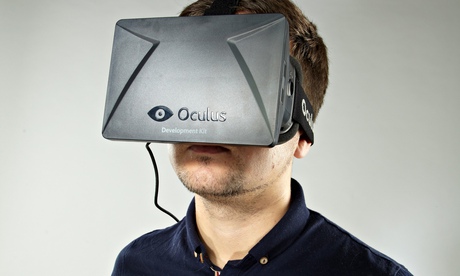
Facebook is hoping to create 1bn users for its virtual reality (VR) acquisition, Oculus. Sounds overly ambitious doesn’t it? But not impossible. After all, Google managed this level of adoption for Android. So let’s assume for a moment that it’s feasible and ask ourselves how mass uptake of VR will affect media and marketing?
VR is most commonly associated with gaming, where the kinship is clear. Perhaps the most obvious media connection is with Hollywood, where VR has the potential to completely revolutionise the film industry. From giving every viewer an IMAX-worthy “best seat in the house” to letting people interact with a film’s narrative and pause to reveal character backstories, VR has the power to utterly disrupt the passive film viewing experience.
If this sounds far-fetched, it’s not. Although we’re yet to witness the release of the world’s first VR Hollywood film, the BBC has already opened the floodgates. During its recent coverage of the Commonwealth Games, Oculus Rift headsets could be used to submerse viewers into 360-degree videos and three-dimensional audio.
Sporting events have a natural affinity with VR; what better way to bring people who can’t be at the stadium closer to the action? But any live event could benefit. Can’t get a ticket to Glastonbury? The BBC can take you there – and I don’t just mean via soon-to-expired BBC Three. It could take you there through a VR headset that lets you interact with other virtual Glasto-heads and viscerally bring that festival feeling into your living room.
If VR has the ability to disrupt the way we consume media on a mass scale, how should marketing adapt? VR is a huge opportunity for brand world because it has the ability to foster deep, persuasive touchpoints. As Shuhei Yoshida, head of Sony Worldwide Studios, neatly sums up: “We used to say seeing is believing. Now we have to say experiencing is believing.” This means we can no longer solely rely on consumers’ inert viewing as a means of convincingly communicating marketing messages.
Brands and sporting events go together like strawberries and cream. Robinsons currently sponsors Wimbledon. But VR can take this “flat” form of sponsorship to enhanced levels; imagine experiencing and interacting with Wimbledon from the umpire’s chair … brought to you by Robinsons. That’s a powerful experience, something memorable that will keep the brand at the forefront of consumers’ minds.
Brands could also use VR to improve personalised advertising. Formula 1 events already use green screens to create last-minute ads, selling media space in real-time to the highest bidder. Apply VR to this principle and suddenly you have a new channel for finely-targeted advertising. It’s also fairly straightforward; by giving marketers data about VR users, messages can be customised according personal profiles. These VR headsets then become a dynamic route for delivering ultra-personalised advertising.
Earlier this year, Topshop used Oculus Rift to let customers at the Oxford Street store experience its Tate Modern fashion show from the virtual front row. This meant Joe and Jo Blogs could sit next to front row A-listers – an unforgettable encounter likely to create lifelong brand advocates. But this innovative campaign could have been taken even further by embedding the content with shoppable tags. This way, customers could instantly buy outfits they’ve just seen sashaying down the catwalk. It’s a perfect symbiosis of forward-thinking marketing and cunning sales tactics.
In the not too distant future we could even see brands using VR to bring celebrities back from the dead. In the same way that we at Framestore recreated Audrey Hepburn as a 2D entity for Galaxy, VR has the potential to take this regeneration into a 3D, interactive world.
Having a cup of tea with Audrey? That’s not just a Madame Tussauds novelty; it’s also the beginnings of an immensely influential marketing campaign. If we can find a way of seamlessly combining artificial intelligence with voice recognition and a database of celebrity facts, we’ve cracked it.
This is, of course, a long way off. The technology needed to achieve some of these goals is not quite there yet. All credit to the BBC for spearheading broadcast VR through its Commonwealth Games experiment, but the end result was far from perfect and illustrates how we need to improve resolution and bandwidth in order to deliver truly lifelike VR experiences.
Predicting the future is a risky game. That said, a mere five years ago, the technology we used to resurrect Audrey Hepburn and recreate outer space for Alfonso Cuaron’s Gravity simply didn’t exist. Five years is a long time in the world of tech innovation. Who knows, it may even be long enough for Zuckerberg et al to get the world hooked on Oculus, in the same way they did with Facebook.
Mike McGee is co-founder and creative director at Framestore, which you can follow on Twitter @Framestore
More like this
• Ice bucket challenge: what are the lessons for marketers?
• How drinks brands are using tech to foster deeper relationships
• Why real people make for better brand marketing campaigns
To get weekly news analysis, job alerts and event notifications direct to your inbox, sign up free for Media Network membership.
All Guardian Media Network content is editorially independent except for pieces labelled ‘Advertisement feature’. Find out more here.

